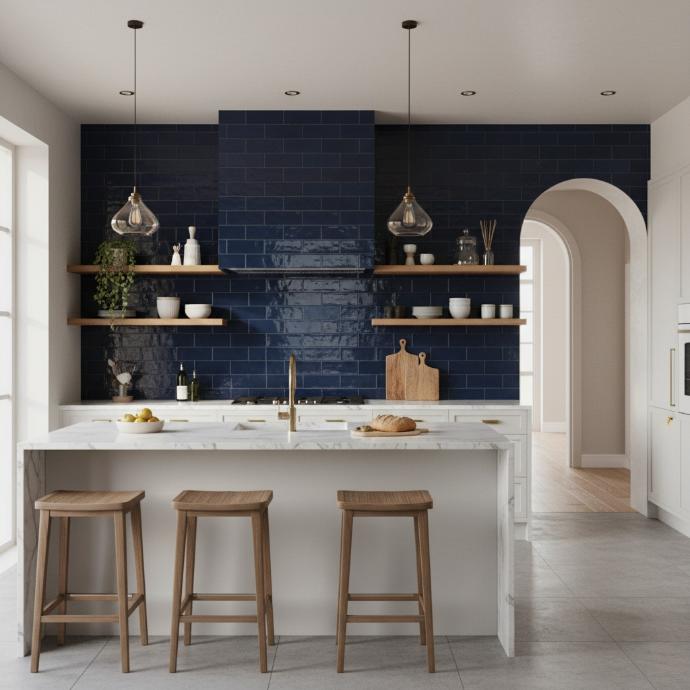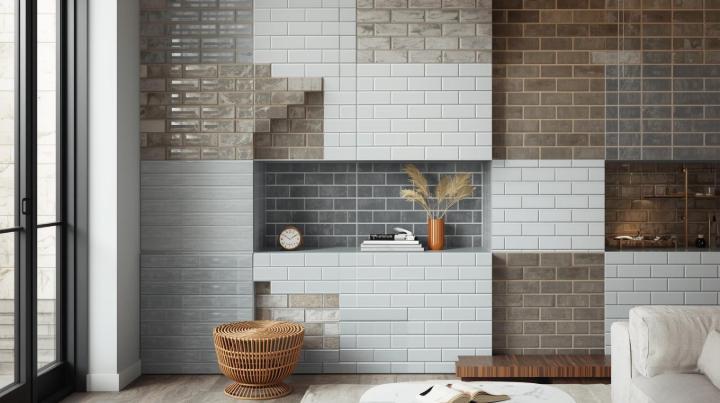Subway tiles are rectangular ceramic or porcelain tiles characterized by their distinctive 3-inch by 6-inch dimensions, smooth glazed surface, and 2:1 aspect ratio. These tiles feature a flat, typically glossy finish and are most commonly installed in a horizontal running bond (offset brick) pattern, though modern applications include vertical stack, herringbone, and chevron arrangements.
Traditional Subway Tile Design
Initially introduced in New York's subway infrastructure in 1904, subway tiles were engineered with utility, longevity, and hygiene as priorities. The earliest versions utilized white glazed ceramic, selected for their ability to reflect light and resist both staining and bacterial growth. Through the years, what started as strictly utilitarian has transformed into a design vocabulary that expresses clarity, structure, and perpetual appeal. This evolution demonstrates the tile's capacity to merge historical aesthetics with contemporary application.
Defining Features
Traditional subway tile derives its unmistakable character from several uniform, precisely determined qualities. From dimensional proportions to surface application, every component contributes to both visual attraction and practical performance. Collectively, these attributes ensure subway tile maintains its status as a design cornerstone in both home and business environments. Recognizing these qualities enables you to completely grasp what establishes this tile configuration as truly emblematic.
Shape
The characteristic attribute is its conventional rectangular configuration with a 2:1 dimensional ratio, adhering to golden proportion concepts of visual equilibrium. This proportion guarantees that when tiles are positioned in horizontal rows, they deliver a harmonious and rhythmic linear visual presentation, frequently employed in spatial regulation and perspective enhancement in design. The recognizability of this configuration also provides a reassuring sense of structure to interiors. It's an aspect that quietly strengthens symmetry while avoiding rigidity.
Surface
Initially kiln-processed and glazed utilizing a lead-containing vitreous coating, current tiles employ lead-free enamels and UV-protected glazes. The shine intensity spans from high-gloss (>70 GU) to matte (<15 GU), which influences reflectivity and light dispersion in an environment. The glaze creates a vitrified surface, enhancing chemical resistance (per ASTM C650) and surface hardness (Mohs scale of ~5–6). This coating not only safeguards the tile but also magnifies its visual presence.
Size
The archetypal dimension is 3"x6", delivering a modular component that facilitates straightforward layout coordination, particularly in running bond or herringbone configurations. Contemporary formats encompass metric adaptations and imperial variations, with calibrated edges (exact, machine-trimmed edges) or cushioned edges (gently rounded, typically present in conventional ceramics). These alternatives preserve the tile's fundamental proportions while introducing nuanced customization opportunities. Consequently, they deliver adaptability while maintaining the foundational character. Explore our complete collection of tiles organized by size to find the perfect dimensions for your project.
Pattern
The running bond or staggered brick arrangement delivers lateral steadiness during placement, reducing noticeable irregularities in wall surface evenness. This configuration creates aesthetic movement while avoiding excessive visual complexity and proves especially successful in establishing linear flow in elongated, confined areas such as corridors or galley-style kitchens. It's also a design approach that introduces organization without dullness. Across time, its adaptability has demonstrated both lasting relevance and broad applicability.

Material Selections
Material choice substantially affects a tile's resilience, moisture protection, and aesthetic character. Each selection, from ceramic to natural stone, possesses distinct technical characteristics appropriate for varied settings. By selecting the suitable material, you guarantee both sustained performance and design harmony. Here's an in-depth examination of what each selection provides.
Ceramic
Crafted from red or white clay, ceramic tiles undergo firing at reduced temperatures compared to porcelain (~1,000–1,200°C), rendering them somewhat more absorbent (absorbing >3% water per ANSI A137.1 specifications). They're economical, lightweight, and perfect for vertical uses where impact durability isn't crucial. Especially appropriate for wall placements, ceramic tiles are regularly utilized for backsplashes, bathroom walls, and additional dry to moderately damp locations. They also provide the broadest spectrum of finishes and designs, establishing it as a pragmatic selection that doesn't sacrifice design quality.
Porcelain
Constructed of kaolin-concentrated clay and fired at elevated temperatures (>1,200°C), porcelain tiles possess a water absorption capacity of <0.5%, designating them as impervious (per ANSI A137.1). This establishes them as perfect for showers, moisture-heavy rooms, or outdoor facades. Frequently obtainable in rectified configurations, they permit narrow grout joints (<1/8") for a continuous appearance. Their compactness and resilience establish them as a favored selection in high-traffic zones and particularly appropriate for floor placements where moisture protection and extended wear are essential. Learn more about the differences between porcelain vs ceramic tiles to make an informed decision.
Natural Stone (Marble, Slate, Granite)
These substances are extracted, sectioned, and frequently honed or buffed. Marble (calcite-derived) provides veining and luminosity but demonstrates acid sensitivity (responds to vinegar or citrus). Slate and granite are silicate-derived, delivering elevated Mohs hardness and protection against etching. With appropriate sealing, these premium materials deliver beauty and strength, establishing them as perfect for significant design expressions.
Contemporary Variations of Subway Tile
In modern design, subway tile surpasses its beginnings to function as a medium for artistic expression. Contemporary variations present daring proportions, innovative colors, sensory finishes, and creative patterns that mirror current design approaches, spanning from minimalism to maximalism, nature-inspired design to industrial aesthetics. These reinterpretations honor the tile's legacy while creating opportunities for individual creativity. The outcome is an adaptable material that addresses a diverse range of design vocabularies.
Size Alternatives
Modifying the dimensions of subway tiles provides more than visual diversity, it shapes how illumination engages with an environment and how tile arrangements appear across a surface. Various formats introduce specific benefits for different spatial scales and purposes. Whether generating elaborate detail with compact tiles or a unified effect with expansive ones, dimension becomes a compelling design instrument. Comprehending these principles enables you to select with assurance based on spatial and stylistic requirements.
Compact Formats (1" x 2", 2" x 4")
Utilized chiefly for intricate uses, these tiles accommodate high-density arrangements like mosaics or detailed borders. Compact tiles present additional grout lines, which can be color-coordinated or contrasted to generate patterns and cadence. Perfect for moisture-prone zones due to enhanced slip protection from increased grout, they also deliver a handcrafted, personal quality. Nova Tile And Stone offers an extensive selection of tile types in narrow formats with sophisticated, gentle matte coatings, ideal for backsplashes, bathroom alcoves, or environments where understated elegance and surface dimension are sought.
Expansive Formats (4" x 8", 6" x 24")
Conversely, large-dimension tiles minimize grout lines, improving visual continuity and simplifying surface cleaning. They demand a more level substrate owing to heightened potential for lippage (edge elevation variance). These formats frequently utilize rectified porcelain to sustain edge uniformity and are prevalent in upscale, minimalist spaces. For instance, Nova Tile And Stone's large format porcelain subway tiles deliver dramatic elongated profiles and deep, earthy pigments, perfect for accent walls or open-layout floors where you desire to combine distinctive character with continuous flow.

Color Investigation
Color choice represents one of the most influential instruments in tile design. It establishes the emotional atmosphere, enhances the wider palette, and even impacts the perception of illumination and space. Selecting the appropriate shade can convert a room from peaceful to energetic, minimalist to striking. In contemporary interiors, subway tile assumes a renewed identity through the application of daring colors, profound neutrals, and tonal grout pairings, recasting a traditional shape in a distinctively modern manner. Browse tiles by color to discover options that complement your design vision.
Pattern Innovation
Patterns extend beyond visual interest, they can improve spatial circulation, interrupt monotony, or generate directional flow in a room. The appropriate arrangement can subtly strengthen architectural elements or function as a focal point. Pattern also influences how tiles engage with adjacent design components. In contemporary interiors, unconventional arrangements like vertical stacks, herringbone, or chevron reimagine the conventional subway tile configuration, converting it into an expression of modern design. For inspiration on kitchen trends in 2025, consider how pattern choices reflect current aesthetic movements.
Textural Innovation
Beyond color and dimension, texture introduces depth and tactile complexity to subway tiles. Surface treatments can alter a room's character from clinical to inviting or refined to rustic with considerable effect. Texture also engages with light uniquely compared to flat surfaces, introducing dimension and subtlety. In contemporary spaces, matte, brushed, or gently irregular finishes reinterpret the traditional subway tile with a modern sensibility, introducing softness, refinement, and tactile appeal to streamlined interiors.
Subway Tile Across Different Spaces
Subway tile may be universally identifiable, but its application differs substantially from space to space. Each area in a residence presents distinct requirements, shaping the selection of tile material, finish, and arrangement for ideal performance and visual impact. By customizing selections to the requirements of each setting, you ensure that both appearance and utility are respected.
Kitchen Uses
The kitchen represents the most frequent environment for subway tile, especially as a backsplash. Glazed ceramic or porcelain proves optimal here owing to its protection against food splatter, heat, and moisture. A 3" x 6" tile in a running bond arrangement delivers timeless sophistication, while expansive formats or stacked arrangements complement modern cabinetry and open shelving. To improve practicality while preserving style, contrast grout can prove particularly beneficial, assisting in concealing routine cooking stains while introducing visual clarity. Discover stunning small kitchen floor ideas that pair beautifully with subway tile backsplashes.
Bathroom and Moisture Areas
Subway tile represents an optimal selection for high-moisture settings such as showers and bathrooms, where resilience and maintenance simplicity are critical. Among the obtainable materials, porcelain distinguishes itself for its minimal porosity and superior mold protection, establishing it as especially appropriate for moisture zones like shower walls and floors. Meanwhile, ceramic tiles prove better suited for vertical uses; their reduced weight and comprehensive variety of colors, finishes, and formats establish them as ideal for introducing style and gentleness to bathroom walls, vanities, and feature zones.
An excellent illustration is Nova Tile And Stone's Perfection series matte porcelain subway tile, as exhibited in the image above. These tiles integrate calming, nature-derived shades with matte coatings, presenting subtle, organic sophistication that softens the environment without dominating it. The gentle pigments, when matched with the traditional subway configuration, amplify the feeling of serenity and cleanliness, converting daily routines into a peaceful, spa-inspired experience. Explore more bathroom remodel ideas to transform your space.
Entryways and Transition Spaces
Subway tile in transition spaces and entryways fulfills a utilitarian purpose, withstanding daily wear, tracked debris, and moisture exposure. For enhanced safety and warmth, textured porcelain or honed stone tiles represent optimal selections, delivering both slip protection and an anchored aesthetic. Similarly, natural tones in basketweave or staggered patterns establish a rustic, inviting environment, particularly when matched with wooden benches or shaker-inspired cabinetry. Together, these design components integrate resilience with appeal, establishing a fashionable and durable first impression.
Living Spaces and Hearths
While less traditional, integrating subway tile in living rooms and surrounding fireplaces can present unexpected contrast and personality. Heat-protective stone or porcelain tiles prove excellent for framing a hearth, delivering both resilience and a sophisticated visual focal point. For enhanced depth and surface interest, beveled or handcrafted tiles generate subtle shadow variation under ambient illumination, improving the room's total atmosphere. If you're pursuing a striking, design-progressive appearance, matte black or deep green tiles matched with white grout suggest a commanding, contemporary Art Deco aesthetic.
To simplify your selection further, Nova Tile And Stone provides a cut-to-order sample program that enables you to evaluate tile selections directly in your environment before making a purchase. With their 4"x4" samples that ship free, you can assess how various subway tile styles, colors, and finishes will appear alongside your current surfaces, illumination, and design components under your actual lighting conditions. It's an essential step that introduces clarity and assurance to the selection journey, assisting you in converting inspiration into a flawlessly customized outcome.

Selecting the Appropriate Subway Tile
With the marketplace presenting thousands of alternatives, educated selection of subway tile requires a thorough comprehension of your architectural limitations, environmental circumstances, and design objectives. Each determination, color, dimension, material, and pattern should harmonize appearance and utility. Consider not merely aesthetic attraction, but also how each selection supports the distinct requirements of your environment. These directing factors will assist you in making assured and intentional tile selections. Review NKBA planning guidelines for professional design standards.
Total Design Approach
Subway tile adjusts effortlessly to a broad spectrum of interior design approaches, from conventional kitchens to ultramodern bathrooms. For traditional or vintage aesthetics, lustrous white ceramic in a running bond arrangement delivers timeless appeal. Contemporary or minimalist designs, conversely, profit from large-dimension matte tiles or vertical stacking arrangements that improve geometric exactness.
A prime illustration is Nova Tile And Stone's glossy porcelain subway tiles, which, as exhibited in the kitchen above, attractively enhance warm wood cabinetry and brass fixtures, presenting gentle, reflective coatings that amplify light while sustaining understated, natural sophistication. Their neutral tones bridge the gap between conventional and contemporary aesthetics, establishing balanced foundations for mixed-material environments. Narrow format configurations also introduce handcrafted qualities that subtly enhance total compositions without overwhelming additional components. Learn more about our company and our commitment to quality tile solutions. View our complete subway tile collection to explore all available styles.
Color Palette of the Adjacent Environment
The pigment of your subway tile should engage thoughtfully with your room's color scheme, either enhancing or contrasting it. For example, light-pigmented tiles can assist in illuminating dark cabinetry or restricted spaces by reflecting additional ambient illumination. Conversely, darker tiles present depth and intensity, particularly when balanced with lighter countertops or fixtures. Consider undertones and illumination circumstances to sustain color harmony throughout surfaces.
Space Dimensions and Illumination Circumstances
Tile dimension and coating substantially influence how space and illumination are perceived in a room. In compact or dimly illuminated environments, smaller lustrous tiles can improve light reflection and establish the room feeling more spacious. Conversely, large-dimension matte tiles can anchor a bright, expansive room while minimizing visual disorder. Always assess both natural and artificial illumination when choosing your tile to guarantee consistent visual equilibrium.
Intended Degree of Visual Engagement
The arrangement and coating of your subway tile determine how much visual surface interest and motion it introduces to a room. If your environment already showcases striking patterns or complex materials, a understated tile arrangement like stacked bond or tone-on-tone color will sustain equilibrium. Simpler interiors can also profit from commanding patterns like herringbone or chevron to introduce architectural distinction. The objective is to either enhance or gently interrupt your space's visual cadence without dominating it. Consider pairing subway tiles with our mosaic tile options for added visual interest.
Financial Plan and Maintenance Considerations
When choosing subway tile, it's significant to balance your design vision with practical factors like expense, resilience, and ongoing maintenance. Ceramic tiles are typically the most economical selection and demand minimal upkeep, establishing them as an outstanding choice for light-use or ornamental zones. For environments that require more strength, porcelain ceramic tiles deliver superior resilience and moisture protection, though they arrive with elevated initial expenses and more comprehensive care. Review the U.S. ceramic tiles market report to understand current pricing trends and market insights.

Installation and Upkeep of Subway Tiles
Proper installation and upkeep are critical for maintaining both aesthetic attraction and structural soundness. Subway tile may seem straightforward to place, but specifics matter, from substrate preparation to grout choice and curing duration. While DIY methods are feasible, it is frequently optimal to have professional installation, particularly for complex arrangements or high-moisture zones, to guarantee exact alignment, extended resilience, and a genuinely refined completion.
Installation Guidelines
Appropriate tile installation commences with comprehensive surface preparation and selecting the proper adhesive system based on substrate variety and tile material. A level, moisture-resistant backer board proves critical in moisture zones, and tile spacers guarantee uniform joint widths. For intricate patterns like herringbone or basketweave, professional installation may produce the most exact and resilient outcomes. Don't overlook to utilize expansion joints and flexible grout in zones susceptible to movement or thermal fluctuation. Access comprehensive tile installation resources from the Ceramic Tile Foundation for technical guidance, and learn how to grout tile properly for professional results.
Upkeep and Cleaning
Maintaining subway tile appearing pristine requires regular cleaning with non-abrasive, pH-neutral solutions suitable to the tile's coating. Lustrous and porcelain tiles prove easier to sustain, while natural stone and textured coatings may demand sealing and specialized cleaners. Avoid acidic products on marble or gentle glazes, as they can trigger etching or discoloration across time. Establishing a monthly or quarterly cleaning routine and examining grout for deterioration will also assist in extending the longevity and beauty of your tile installation. For detailed guidance, review this tutorial on how to replace bathroom tiles when repairs become necessary.
Why Subway Tile Maintains Design Significance
Subway tile presents lasting adaptability, balancing utilitarian strength with aesthetic flexibility. Whether installing traditional white ceramic in a heritage residence or experimenting with oversized, textured porcelain in a contemporary loft, subway tile enables you to establish spatial character with exactness and style. Through technical knowledge and creative investigation, you can utilize this timeless component to enhance any interior environment. Regardless of the room, purpose, or financial plan, the appropriate subway tile can establish a lasting design expression.
For individualized guidance in selecting the ideal subway tile for your environment, Nova Tile And Stone also provides professional design consultations. Whether you require assistance coordinating colors, choosing patterns, or refining the total aesthetic, our design specialists collaborate with you to actualize your vision with assurance and creativity. It's a beneficial step that guarantees your final selection isn't merely beautiful, but also thoughtfully customized to your distinctive environment. Browse tiles organized by style or visit our local showrooms to experience our selections firsthand.
Conclusion
Subway tiles represent far more than a design trend, they embody a lasting fusion of practicality, sophistication, and architectural flexibility that continues to captivate homeowners and designers across generations. From their humble origins in New York's underground transit infrastructure to their current status as a cornerstone of contemporary interior design, these rectangular tiles have proven their remarkable capacity to adapt, evolve, and remain perpetually relevant.
Understanding what subway tiles look like extends beyond recognizing their signature 3"x6" dimensions or characteristic glossy finish. It involves appreciating the breadth of material options, from economical ceramic to resilient porcelain and luxurious natural stone. It encompasses recognizing how size variations, from compact 1"x2" formats to expansive 6"x24" planks, can dramatically transform spatial perception and visual flow. It means exploring the potential of color, texture, and pattern to convert a simple rectangular tile into a powerful design statement that reflects your unique aesthetic vision.
Whether you're renovating a vintage kitchen backsplash, designing a spa-inspired bathroom retreat, creating a durable mudroom entrance, or establishing a striking fireplace surround, subway tile offers unmatched versatility. The key lies in making informed selections that balance aesthetic preferences with practical requirements, considering factors like moisture exposure, traffic patterns, maintenance commitments, and overall design harmony. For comprehensive renovation guidance, explore how to renovate a house with professional insights.
With Nova Tile And Stone's extensive collection of subway tile options, professional design consultation services, and convenient cut-to-order sample program, transforming your space with this timeless material has never been more accessible. Visit our showrooms in Northern Nevada and Northern California to experience our subway tile selections firsthand, or connect with our design specialists to begin your journey toward creating interiors that seamlessly blend classic elegance with contemporary functionality. Explore our complete product catalog or visit our shop to discover the perfect tiles for your project.
Frequently Asked Questions
What is the standard size of a subway tile?
The traditional subway tile measures 3" by 6", establishing the iconic rectangular proportion that defined the original New York City subway installations. This dimension creates a 2:1 aspect ratio that delivers visual harmony and facilitates straightforward installation in popular patterns like running bond and herringbone. However, contemporary manufacturing has expanded subway tile dimensions considerably. Today's market offers compact formats such as 2"x4" and 1"x2" for detailed mosaic applications, standard variations like 2"x8" and 3"x12", and expansive formats including 4"x8" and 6"x24" that minimize grout lines and create seamless modern aesthetics. Despite these dimensional variations, all maintain the characteristic rectangular subway tile profile.
Can subway tiles be used for shower walls and floors?
Absolutely. Subway tiles excel in high-moisture environments like showers when appropriate materials and installation methods are employed. For shower walls, both porcelain and ceramic subway tiles perform exceptionally well, though porcelain offers superior water resistance with absorption rates below 0.5%, making it impervious according to ANSI A137.1 standards. For shower floors, porcelain subway tile is strongly recommended due to its density, durability, and moisture resistance. Smaller subway tile formats provide an additional advantage for shower floors, the increased number of grout lines enhances slip resistance, improving safety in wet conditions. Proper waterproofing, appropriate substrate preparation, and professional installation ensure long-lasting performance in these demanding applications.
What's the difference between ceramic and porcelain subway tiles?
The fundamental distinctions between ceramic and porcelain subway tiles involve composition, firing temperature, and resulting performance characteristics. Ceramic tiles are crafted from red or white clay and fired at lower temperatures (approximately 1,000–1,200°C), resulting in a slightly porous material that absorbs more than 3% water per ANSI A137.1 standards. This makes ceramic tiles more economical, lighter in weight, and ideal for vertical wall applications like backsplashes and bathroom walls where impact resistance isn't paramount. Porcelain tiles, conversely, are composed of kaolin-rich clay and fired at higher temperatures (exceeding 1,200°C), producing an extremely dense, impervious material with water absorption below 0.5%. This superior density makes porcelain significantly more durable, moisture-resistant, and suitable for high-traffic floors, exterior installations, and wet areas like shower enclosures. Porcelain typically commands higher prices but delivers enhanced longevity and performance in demanding environments.
How do you maintain and clean subway tiles?
Maintaining subway tiles in pristine condition requires regular cleaning with appropriate products matched to your tile's specific finish and material composition. For daily maintenance, use non-abrasive, pH-neutral cleaning solutions that won't damage the glaze or grout. Glossy ceramic and porcelain subway tiles are the easiest to maintain—simply wipe with a damp microfiber cloth and mild detergent to remove splatter and residue. Matte and textured finishes may require slightly more attention, as their surface irregularities can trap dirt more readily. For natural stone subway tiles like marble, avoid acidic cleaners including vinegar, lemon juice, or harsh chemicals, as these can cause etching and permanent discoloration. Instead, use cleaners specifically formulated for natural stone. Establish a consistent cleaning schedule, weekly for high-use areas like kitchen backsplashes, monthly for bathroom walls and periodically inspect grout lines for deterioration, resealing or regrouting as necessary to prevent moisture infiltration and maintain visual appeal.
What installation pattern works best for subway tiles?
The optimal installation pattern for subway tiles depends on your aesthetic objectives, spatial characteristics, and desired visual effect. The running bond pattern, also called offset or brick pattern, represents the most traditional and widely recognized arrangement, where each tile is offset by half its length from the row above. This classic layout provides lateral visual stability, effectively disguises minor wall imperfections, and suits virtually any design style from traditional to contemporary. For modern, streamlined aesthetics, vertical stack or grid patterns create clean geometric lines and emphasize ceiling height, though they require exceptionally flat walls to avoid highlighting surface irregularities. Herringbone and chevron patterns introduce dynamic visual movement and sophisticated elegance, making them excellent choices for feature walls or spaces seeking architectural distinction. These diagonal arrangements demand more complex installation and generate additional material waste but deliver striking results. Basketweave patterns offer rustic charm particularly suited to entryways and transitional spaces. Ultimately, your pattern selection should complement your overall design vision while respecting the practical constraints of your space and installation budget.